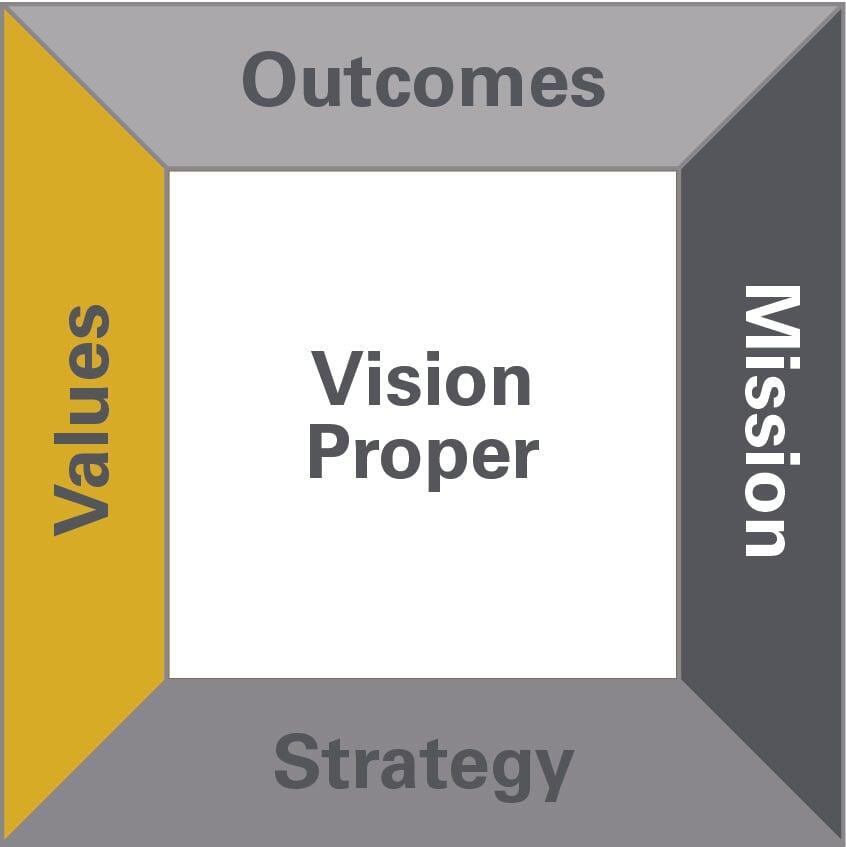If you don’t know where your church is going and what you are doing before you begin to implement your ChMS or any “relationship management system” you’ll never be happy with it.

I always begin church management process discovery workshops with a session on vision, mission, values, strategy, and measures.
The goal of this session is not to set these statements – most churches already have something. The goal of this session is to put those concepts front and center as we work through the requirements of the software.
In one church, I drew the Vision Frame from “Church Unique” on the board and framed the words “Mission, Values, Strategy, and Measures” on the board.
While many (but not all) of the churches I’ve guided through this process use the Auxano Vision Frame, this was the first church I had encountered that had nothing in mind. They existed because they had always existed. Throughout the day, we listed program after program, many well intentioned and good programs. But it became clear that the staff may as well have worked at ten different churches, because each department seemed to have an entirely different view of why they existed and what success looked like.
Their ChMS choice and implementation struggled because there was no clear strategy to which to connect the dots of their ChMS software.
ChMS is a tool to help you execute your strategy
Clear organizational identity is critical to your church being healthy and effective, and digging deep into the process of defining your identity is the subject of a different book. In this chapter, my goal is to set the stage for our ChMS discussions in the context of vision and mission. I use the “vision frame from Church Unique, in part, because so many churches are familiar with it or have implemented it in their community.
Vision

The definition of “vision” that I prefer is simply a description of what our organization’s destination looks like. Sometimes people talk about vision in terms of horizons, with varying distances. Where will we be in 3, 5, or 10 years? What does that look like?
As Christians, we share a long term vision of redemption, of people being made right with God. But how is God working in your local church? What is the vision for your church, your community.
I find it helpful to consider a person – a new guest and think about what their life looks like in 10 years, if they plug in with our church. What does it mean for someone to be “discipled” and for their following Jesus to take shape?
What happens when that experience happens over and over?
What is the impact within your church? Your community? Your country? The world?
Your vision may have several dimensions:
- Geographic Growth
- A description of the spiritual impact you hope to have in people’s lives
- The kind of people you hope to be
- The kind of generational impact you hope to have
Your vision should be specific enough to know you are there when you get there. It should have a timeline.
Vision can be expressed as “from X to Y, by Z.”
It should be unique enough to describe why your church is needed in addition to the many other churches that people could join or attend.
It should be compelling enough to inspire people to invest and contribute.
Mission

If Vision is where we are going, Mission can often be described as what we are doing. What is the action, written as an outcome of our activity.
When Jesus gave the disciples their instruction in the “Great Commission” in Matthew 28:19, he told them to “go and make disciples of all nations, baptizing them in the name of the Father and of the Son and of the Holy Spirit.”
Ultimately, that’s the mission of every church. But of course, every church is a member of Christ’s body, and as some are called to be an arm, others are called to be a foot. So our local mission will be an unique expression of the great commission.
As Will Mancini describes in his book “Church Unique,” each church has a “kingdom concept.” This concept is made up of the intersection of three unique conditions:
- The aspirational esprit – This is the “thing” that excites your leadership. It’s a major part of the DNA of the church and even as leaders come and go – this usually reflects the founder’s excitement. After all, whatever that was – it’s also what attracted your first members and guests. This could be evangelism, care for the poor, outreach, theological teaching, arts, or other expressions of faith. While you may do ALL of these things, there are probably a couple that especially excite your leaders, and your church family.
- The collective potential – Your church family is made up of people with unique giftings. It’s often the case that “birds of a feather flock together,” and there is a common thread of some type of gifting. Perhaps your church is uniquely gifted with hospitality, or people who are equipped to serve others’ physical (or fiscal) needs. Some churches just happen to be blessed with may gearheads who love working on cars, while others are equipped with business strategists.
As you can see – these three aspects of your church community are related (it’s probably no surprise that a church in lower Manhattan might be abundant in white-collar graduate school educated financial experts, led by an intellectual pastor with an excitement to help educated people get out of the way of their own overthinking, where the local predicament is financial idolatry and self-sufficiency!)
The kingdom concept is a very helpful tool in understanding your mission.
Because – you will do what your church is equipped to do, what your pastor is excited to lead, and, if you are wise, you will do it in the context of the people God has given you to serve.
As with vision, mission should be specific. It’s the most core thing that you hope to do, to make the change that you hope to make.
As my friend Mike Kelly puts it in his book “The Meaning is the Mission,” mission is the engine that drives your “vision vehicle.”
Values

As we work through Will Mancini’s Vision Frame, we come next to values. Will describes values as the principles that drive our decision making. They are the “why” in the chaos.
Mike Kelly calls values the “steering wheel that keeps our vision vehicle out of the ditch.”
Values are foundational – they are the “covenant in the chaos” and are our one of our best tools for being true to who we really are.
When defining your values, it’s important that they be true. Patrick Lencioni describes three traps to avoid when defining values:
1) Aspirational values – these are those values that aren’t really ours. We respect them in other people, but we don’t really hold to them. It’s important that your values describe who you are at your best, but aren’t only who you wish you were.
Example: A church may say they value “every member serving” but every member expects a paid staff member to do the work.
2) Permission-to-play – Permission to play values are minimum standards for acceptable behavior.
- Example: Honesty (let’s hope so!)
3) Accidental Values – These kids of values tend to represent early values of the founding leaders and team. If they aren’t true today, they may need be revisited!
- Example: A church for whom the founding pastor valued knowing every member by name, but due to size and changes in leadership, that level of personal relationship just isn’t a reality anymore.
Strategy

Strategy is how you will go about getting to your destination. Don’t skip this one! It’s the connective tissue of this compelling vision and the many different things that go into making it happen. If this is a trip, strategy is the roadmap.
Earlier – I described a church taking a mission trip to New Orleans. Strategy is how we will get there. In that scenario, we have options. We could take a bus, several vans, individual cars, 50 motorcycles, or a plane! From Nashville, we could take I-65 south to Birmingham, then I-59 to New Orleans. Or, several dozen other possible routes.
All of these decisions come together to create a strategy for our trip – and they are all connected.
In a similar way – your strategy for ministry in your church has options.
Your discipleship mission may be executed via Sunday classes, home-fellowship groups, weekday Bible studies. Or all of them. Or in some other way altogether.
Your outreach and missions mission may be executed via a soup kitchen at the church, or via a partnership with a local after school ministry, or via annual mission trips, or… well, you can see where this is going.
Most of the churches I’ve helped work through Church Management problems with describe strategy with their own version of these five categories:
- Community (get in a small group)
- Service (help out on Sunday morning or lead a community group or class)
- Mission (go on a mission trip or volunteer in a local outreach project)
- Generosity (give money to the church)
These are all important things and in many ways – like the “permission-to-play” values, they are the things that most churches in 2024 do.
If I can encourage you to dig a little deeper and get more specific on your strategy, describing how each of the programs and methods of your strategy connect to your ultimate vision, I think you will find it to be much more effective.
For each program in your strategy, ask how it helps you execute your mission and vision. For those programs and activities that can’t clearly connect to your mission and vision, or that don’t actually line up with your values, consider whether it really should still be in the mix.
Measures

The final aspect of the Church Unique vision frame addresses measures. Measures are simply the signs that tell us what we need to know about whether we are succeeding or not.
Sometimes, you’ll hear measures described as key performance indicators, or KPIs. There are lead measures and lag measures that we need to consider.
Lead measures are important measures that we have control over. They help us to “predict” other measures. A lead measure might include the number of invitations you send to your community prior to Easter services, or whether your shepherding team is regularly calling to check-in on your members. Lead measures lead to lag measures.
We have limited control over lag measures, and we measure them after the fact. We can’t control, for example, how many people come to the Easter service, but combined with the lead measure of the number of invitations we sent, we can get some sense of how effective the invitations were. In some cases, we can understand a baseline expectation. Perhaps, we can know that on average, if we call 10 people and thank them for their visit, 5 will say they will come to the welcome class, and 2 will actually show up. Then we can adjust our strategy accordingly.
I like to think of measures in this context as similar to the measures we might see in our vehicle on our trip.
As we continue our analogy journey to New Orleans, there are several measures that we need to pay attention to:
·The dashboard – our dashboard will give us important health information about the vehicle, such as how much fuel we have, how many miles remain until we run out of fuel, oil level, tire pressure, speed, etc. Some of the dashboard gauges are critical, while others may be mere information. On a modern, automatic transmission vehicle, RPM is not a critical gauge, yet it takes up an inordinate amount of space on the dash. Other critical gauges and lights indicate when there is a problem needing urgent attention, or sometimes non-urgent attention. My car likes to inform me months before I run out of washer fluid.
·Mile markers – along the road, we pass mile markers and signs that let us know where we are, relative to where we are going. Should we need help, the mile markers give us a location to which we can direct help. Other signs indicate the distance to major intersections and cities.
Similarly, your church management software can provide you with vital details about the health of your church. Setting the right measures, in alignment with your vision and mission can help you make decisions and know where to devote time and energy in your ministry efforts.
Your church dashboard should include key information about how people are engaged in the church. You might include trends to help you know whether you are heading in the right direction over time. Be careful to include only metrics that are relevant to your vision and mission. Many churches track irrelevant details because they “always have.” Like the RPM gauge in my car, it is a distraction from the numbers that really matter. If you won’t change behavior because of the direction a measure is going, why are you tracking it?
The Context and Connective Tissue Between Your Vision Frame and ChMS
The Vision Frame is a helpful tool to think about your church’s Vision, where you are going within the context of the Great Commission. To recap:
·Vision is a medium to long-term future state of where you want your church and your members and church community to be and what you hope to become. It’s the “picture” at the center of the frame. Vision is where we are going. Vision should be aspirational, but not unattainable.
·Mission is the actions we take to move toward this vision. Mission is what we are doing.
·Values are the shared principles that drive our decision-making and provide a “covenant-in-the-chaos.” Values are why it matters.
·Strategy is how we will execute the mission. Strategy is a roadmap that helps make sense of the journey – including the path we plan to take, how to deal with obstacles. Strategy includes the practical programming and structure in which the church operates.
·Measures are the milestones that help us know whether the strategy is working, give vital health signs for our church congregation or parish, and help us to know when we are arriving at the visionary destination.
Church Management Software provides the tools that help you manage the day-to-day aspects of your church. In particular, ChMS connects directly to the strategic elements of structure and programming, managing the relationship of people (aka disciples) to the church. In managing these relationships, ChMS tracks the key engagements that feed your church’s measures.
Your ministry strategy for how you will disciple, shepherd, and care for people should define how you use your church management software. This book endeavors to provide practical application in using ChMS to disciple, shepherd, and care for your flock more effectively.
Through the years, I’ve observed that main reason that churches struggle to gain the effectiveness they desire in their ChMS stems from a lack of definition in these key strategic areas of discipleship, shepherding, and care. If the people and process steps that you hope to manage and automate are unclear; if the people who are responsible to make decisions and implement those decisions are unclear, you will struggle to get the desired benefit from your software.
·Welcoming people into your church and moving them to belong is a process. Each person who ends up at your church follows a similar but unique journey of awareness to familiarity and trust, before they commit and begin to invest themselves into the church’s mission and vision. Some names for this process in the church include “New to Connected,” “Assimilation,” “Next Steps,” and “Growth Track.” No matter what you call it, you can use ChMS to be more intentional about helping new guests move forward in their own journey.
·Discipleship and formation involve the formal and informal ways that people learn and grow. ChMS can help you track the engagement and involvement in your discipleship and formation programming. What are the key programs and activities that you want to keep track of?
·Shepherding the “flock” is the ongoing process of guiding and protecting those in your care. Have you ever bumped into someone at the grocery store, realized you haven’t seen them in a while, and then they tell you they’ve been going to another church for 6 months and nobody noticed? One of the biggest benefits of ChMS being used well, is the ability to help you make sure that people feel seen, heard, and cared for by helping your team of staff, leaders, and volunteers be more intentional about reaching out and contacting your members.
·Caring for the sick, poor, widows, and orphans is a Biblical mandate. ChMS can help you to ensure that these needs are assigned and followed-through.
In the coming posts, we will dig deep into eleven key functions of ChMS, tying each to the bigger picture of your Vision and Mission, and identifying best practices for success in each.
Need help?
If you're struggling to get your ChMS aligned with your ministry vision - or if you're struggling to get your team aligned in the first place, we'd love to help!
